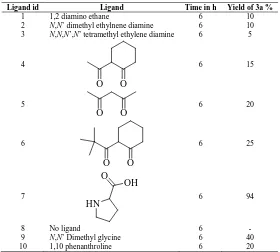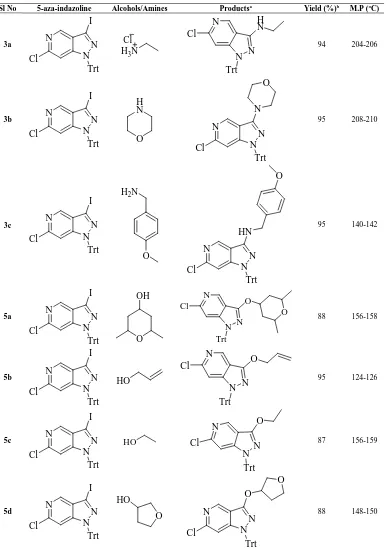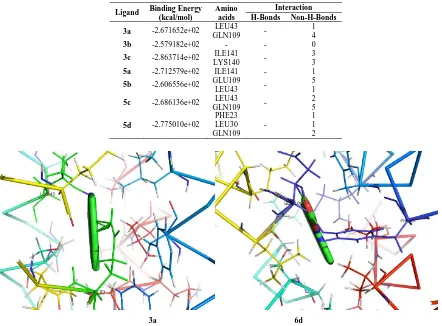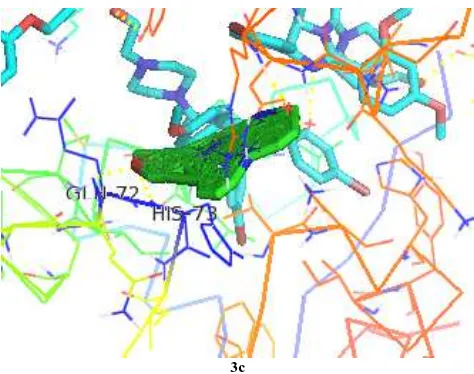Journal of Chemical and Pharmaceutical Research, 2014, 6(8):143-152
Research Article
ISSN : 0975-7384
CODEN(USA) : JCPRC5
Synthesis and molecular docking studies of 1-trityl-5-azaindazole derivatives
Jagadeesh N. Masagalli
1, Kittappa M. Mahadevan
1*, Eranna Siddalingmurthy
1and
Preenon Bagchi
2a
Department of Post Graduate Studies and Research in Chemistry, School of Chemical Sciences,
Kuvempu University, Shankaraghatta, Karnataka, India
b
Department of Bioinformatics, Azyme Biosciences Pvt. Ltd., Bangalore, India
_____________________________________________________________________________________________
ABSTRACT
Synthesis of a series of 3-amine/alkoxy substituted-azaindazoles (3a-c, 5a-d) by Ullmann coupling reaction was described. The advantage of this method includes selectivity between chloro and iodo groups to words the coupling of alcohol and amine nucleophiles which occurred only with iodo group. The selectivity was found to be almost 100 % in both amines (2a-c) and alcohols (4a-d) as incoming nucleophiles. All new compounds were subjected to molecular docking study with Murine double minutes-2(MDM2) receptor bind p53 and Pheripheral benzodiazepine receptor (PBR) cancer proteins. The results reveals that the structures 3a-c and 5a-d were shown more number of binding interactions with the active site amino acids such as LEU43, GLN109, ILE141, LYS140, PHE23 and LEU30 in PBR receptor protein with binding energy ranging from -2.579182e+02 to -2.863714e+02 respectively. However, the compound N-(4-methoxybenzyl)-6-chloro-1-trityl-1H-pyrazolo[4,3-c]pyridin-3-amine (3c) alone exhibits very high bonding interaction with active site amino acid GLN72 and HIS73 in MDM2 receptor bind p53 protein which shows binding energy -3.592025e+02 kcal/mol.
Keywords: 5-Aza indazole, Ullmann coupling, PBR, MDM2-p53, Lipinski rule.
_____________________________________________________________________________________________
INTRODUCTION
______________________________________________________________________________
N
N N R1
R2
N
N N R3
R2
R1
[image:2.595.83.516.68.209.2]Reported structure (a) Synthesized structure (b)
Figure 1
Regarding their synthesis, there are only a few methods, and substitution on 3rd position with nucleophiles are met with limited success only [11]. Since the lack of reactivity in traditional nucleophilic substitution reaction of indazoles, only direct amination of indazole at 3rd position was reported for 3-nitroindazole, which involves very harsh reaction condition.3 Although many palladium catalyzed coupling reactions are known, they suffered due to low yield and use of expensive reagents [12]. Hence encouraged by our continued research on synthesis of heterocyclic compounds [13-20]for against anticancer activity, in this report our attention was turned to synthesize various N-trityl-3-amino/alkoxy substituted 5-azaindazoles using Ullmann coupling reaction due to the wide spectrum of biological activities of indazole nucleus. So in this work we report the Ullmann coupling reaction of 6-chloro-3-iodo-1-trityl-1H-pyrazolo[4,3-c]pyridine with different alcohol and amines to produce novel N-trityl-3-amino/alkoxy substituted 5-azaindazoles (3a-c, 5a-d). As a part of preliminary investigation on interaction of protein-ligand which plays a key role in rational drug design, the molecular docking was performed with all new synthesized compounds against PBR and MDM2-bind p53 cancer causing receptor proteins. Thus we were able to predict and identify most promising candidates as DNA-interactive moiety which potentially endowed with antitumor activity. Most importantly the possibility of making various derivatives was described which makes the research to produce as many as possible indazole ligands for future biological trials to test against different aliments.
EXPERIMENTAL SECTION
The chemicals and reagents obtained from HiMedia, Sigma-Aldrich Chemical Company were used as received. Melting points were determined in open capillary and were uncorrected. Purity of the compounds was checked by TLC on silica gel and compounds were purified by using column chromatography. 1H NMR and 13C NMR spectra were recorded on a Bruker supercon FT NMR (400 MHz) spectrometer in CDCl3 or DMSO-d6 and TMS as an
internal standard. The chemical shifts are expressed in δ units. Mass spectra were recorded on a JEOL SX
102/DA-6000 (10 kV) FAB mass spectrometer.
Typical procedure for the synthesis of 6-chloro-N-ethyl-1-trityl-1H-pyrazolo[4,3-c]pyridin-3-amine (3a) To a solution of ethylamine hydrochloride (0.155 g, 0.0019 mol) in DMSO 5 mL was added anhydrous potassium carbonate (0.396 g, 0.0028 mol) followed by CuI (0.036 g, 0.0001 mol) and proline (0.220 g, 0.0001 mol). The reaction mixture was stirred at ambient temperature. After 5 min, the 6-chloro-3-iodo-1-trityl-1H-pyrazolo[4,3-c]pyridine (0.250 g, 0.0004 mol) was added. The resultant mixture was heated to 80 °C for 5 h. After completion of the reaction as indicated by TLC, the reaction mass was cooled to room temperature and diluted with water, the crude product was extracted into ethyl acetate (3 × 10 mL). The organic layer was washed with brain solution, dried over anhydrous sodium sulphate and concentrated to get residue. The residue was triturated with mixture of hexane and ether to get title compound 3a (Yield = 0.78 g, 94 %) as cream white solid. Similarly all other derivatives 3b-c and 6a-d were synthesized.
Spectral Data:
6-chloro-N-ethyl-1-trityl-1H-pyrazolo[4,3-c]pyridin-3-amine (3a)
1H NMR (400 MHz, CDCl
3): δ = 8.52 (d, J = 1.2 Hz, 1H), 7.29-7.23 (m, 15H), 5.83(d, J = 0.8 Hz, 1H), 4.05 (s, 1H),
3.35-3.29 (m, 2H), 1.21 (t, J = 7.2 Hz, 3H) ppm; 13C NMR (100 MHz, CDCl3): δ = 148.6, 147.5, 146.8, 142.4,
142.1, 130.0, 127.6, 127.5, 114.2, 107.1, 38.7, 14.8 ppm; MS. m/z = 439.0 (M+1), 440.0 (M+2).
5-chloro-3-morpholino-1-trityl-1H-indazole (3b)
1H NMR (400 MHz, CDCl
3): δ = 8.99 (s, 1H), 7.36-7.17 (m, 15H), 5.82 (s, 1H), 3.72 (s, 4H), 3.31 (d, J = 10 Hz,
4H) ppm; 13C NMR (100 MHz, CDCl3): δ = 150.9, 147.6, 143.1, 141.9, 130.2, 127.9, 114.2, 107.7, 79.1, 66.4, 49.3
N-(4-methoxybenzyl)-6-chloro-1-trityl-1H-pyrazolo[4,3-c]pyridin-3-amine (3c)
1H NMR (400 MHz, CDCl
3): δ = 8.77 (s, 1H), 7.33-7.16 (m, 17H), 6.78 (d, J = 8.5 Hz, 2H), 5.87 (s, 1H), 4.36 (s,
2H), 3.79 (s, 3H) ppm; 13C NMR (100 MHz, CDCl3): δ = 130.1, 128.2, 128.1, 114.1, 113.5, 55.3, 16.4 ppm; MS.
m/z = 531.0 (M+1), 532.2 (M+2).
6-chloro-3-(2,6-dimethyl-tetrahydro-2H-pyran-4-yloxy)-1-trityl-1H-pyrazolo[4,3-c]pyridine (5a)
1
H NMR (400 MHz, CDCl3): δ = 8.65 (d, J = 0.8 Hz, 1H), 7.31-7.19 (m, 15H), 5.85 (d, J = 0.8 Hz, 1H), 1.95-1.91
(m, 2H), 1.58-1.36 (m, 3H), 1.33 (d, J = 2.8Hz, 2H), 1.15 (d, J = 6.4Hz, 6H) ppm; 13C NMR (100 MHz, CDCl3): δ =
154.6, 147.7, 145.7, 142.4, 141.9, 130.0, 127.9, 112.6, 107.7, 79.2, 73.4, 71.3, 68.1, 36.5, 21.9 ppm; MS. m/z = 524.2 (M+1), 525.2 (M+2).
3-(allyloxy)-6-chloro-1-trityl-1H-pyrazolo[4,3-c]pyridine (5b)
1H NMR (400 MHz, CDCl
3): δ = 8.76 (s, 1H), 7.28-7.21 (m, 15H), 6.08-5.97 (m, 1H), 5.87 (d, J = 1.1 Hz, 1H),
5.38-5.25 (m, 2H), 4.75-4.72 (m, 2H) ppm; 13C NMR (100 MHz, CDCl3): δ = 154.9, 147.8, 143.2, 143.0, 142.1,
132.3, 130.1, 127.9, 119.2, 112.2, 107.5, 78.9, 70.2, 70.1 ppm; MS. m/z = 452.2 (M+1), 453.2 (M+2).
6-chloro-3-ethoxy-1-trityl-1H-pyrazolo[4,3-c]pyridine (5c)
1H NMR (400 MHz, CDCl
3): δ = 8.68 (s, 1H), 7.30-7.29 (m, 9H), 7.26-7.21 (m, 6H), 5.84 (s, 1H), 4.28 (q, J = 7.2
Hz, 2H), 1.37 (t, J = 6.8 Hz, 3H) ppm; 13C NMR (100 MHz, CDCl3): δ = 155.3, 147.8, 143.1, 142.2, 130.1, 127.8,
112.3, 107.4, 78.8, 65.4, 14.5 ppm; MS. m/z = 440.4 (M+1), 441.4 (M+2).
6-chloro-3-(tetrahydrofuran-3-yloxy)-1-trityl-1H-pyrazolo[4,3-c]pyridine (5d)
1H NMR (400 MHz, CDCl
3): δ = 8.69 (s, 1H), 7.31-7.21 (m, 15H), 5.87 (d, J = 0.8 Hz, 1H), 3.97 (d, J = 8.4 Hz,
2H), 3.91-3.90 (m, 1H), 3.86-3.82 (m, 2H), 2.16 (t, J = 7.6 Hz, 2H) ppm; MS. m/z = 452.2 (M+1), 453.2 (M+2).
In silico molecular docking study
The crystal structure of MDM2 receptor bind p53 tumor suppressor protein (PDB ID: 1RV1) shows over expression in transcriptional inhibition and impairs the p53 function, this characteristic shows inhibition of further downstream pathways.[21] Another protein peripheral benzodiazepine receptor (PBR) (PDBID: 1EQ1)[22] helps translocation of cholesterol and porphyrin across the mitochondrial outer membrane and helps for steroid biosynthesis [23], cellular respiration [24], proliferation [25] and apoptosis [26]. The X-ray crystal structure of MDM2 receptor bind p53 and PBR with stereochemical activity was predicted using structural analysis and verification server (SAVS). The new active sites of MDM2 receptor bind p53 and PBR with nonpolar integration of valid amino acids were predicted using Q-site finder [www.bioinformatics.leeds.ac.uk/qsitefinder]. The chemical structures of the synthesized compounds were drawn using ChemDraw Ultra 8.0. The docking studies were performed using HEX 6.3 software. Hex is protein docking software using spherical polar Fourier Correlations. Hex is an interactive molecular graphics program for calculating and displaying feasible docking modes of pairs of protein and DNA molecules. Hex can also calculate protein-ligand docking, assuming the ligand is rigid, and it can superpose pairs of molecules using only knowledge of their 3D shapes.
RESULTS AND DISCUSSION
To begin with our aim to synthesize N-trityl-3-amino/alkoxy substituted 5-azaindazoles (3a-c, 5a-d, Scheme 1, 2), the azaindole 1 was selected as key intermediate. From key intermediate 1, we opted Ullmann coupling, in which our task was not simple because, mere heating 1 with 2a using CuI 5 mol %, K2CO3 did not give even traces of
desired product. Hence we thought to choose the proper ligand in order to activate the copper.
Thus we successfully carried out the coupling of azaindazole 1 with ethyl amine hydrochloride 2a in presence of proline as coupling ligands along with CuI/K2CO3 in the model reaction. Again the variation of solvent, temperature
and mol ratio revealed that a 1:2 ratio of azaindazole 1 and ethyl amine hydrochloride 2a, 10 mol % CuI, 10 mol % of proline and 5 equivalence of K2CO3 in DMSO at 80 oC furnished highest percentage yield of the products.
N,N-______________________________________________________________________________
[image:4.595.158.438.155.407.2]dimethyl glycine in which about 40 % yield was obtained (based on LCMS). Surprisingly, when we replace N,N-dimethyl glycine to proline the reaction proceeded smoothly to give 94 % yield without any side product.
Table 1. Effect of nature of ligand on the synthesis of 3a using 10 mol % CuI/K2CO3 in DMSOsolvent
Ligand id Ligand Time in h Yield of 3a %
1 1,2 diamino ethane 6 10
2 N,N’ dimethyl ethylnene diamine 6 10
3 N,N,N’,N’ tetramethyl ethylene diamine 6 5
4
O O
6 15
5
O O
6 20
6
O O
6 25
7
HN
OH O
6 94
8 No ligand 6 -
9 N,N’ Dimethyl glycine 6 40
10 1,10 phenanthroline 6 20
Further to assess the scope of this coupling reaction different amines and alcohols were chosen as nucleophiles. The results are summarized in table 3. Thus the reactions of azaindazole 1 with ether 2c gave 95 %, with cyclic ether 4a gave 88 % and with alkene 4b gave 95 % of the corresponding products. Further it was noteworthy to mention that the coupling reaction did not take place with chloro substitution. Hence this coupling reaction shows selectivity with only iodo group in compound 1.
Further we compared the scope of this method with Buchwald and Hartwig coupling reaction. Thus we took 5 mol % of palladium tetrakis, palladium brettphos precatalyst and palladium Xphos precatalyst in dioxane as solvent and with Cs2CO3 base. The results are summarised in table 2. In all the cases a mixture of chloro and iodo displaced
product was obtained. However the best results were obtained with palladium Xphos precatalyst i.e., 80 % desired product and 10 % of chloro displaced product. But practically all palladium catalysts were generally moisture sensitive and very expensive. But on the other hand Ullmann coupling reaction is less expensive, not moisture sensitive and so all the reactions were easily carried out.
Table 2. Selective displacement of iodo group in the presence of various catalyst for the synthesis of 3a in DMSOsolvent
Reaction condition Chloro displacement Iodo displacement
Palladium tetrakis 5 mol %, Cs2CO3 - 50 %
Palladium brettphos 5 mol %, Cs2CO3 20 % 70 %
Palladium Xphos 5 mol %, Cs2CO3 10 % 80 %
[image:4.595.155.439.592.640.2]N N N Cl I Trt O HN HNR1R2(2a-c)/ ROH(4a-d)
O
H2N
H2N
1 X= N, (3a-c)
Trt= CuI 10mol%, Proline
K2CO3/DMSO, 80 oC, 4-5 hr
N N N Cl X Trt R
X= O, (5a-d)
O O
HO HO HO
HO
2a 2b 2c
4a 4b 4c 4d
Scheme 1. Synthesis of 6-chloro-1-trityl-5-azaindazole-3-amine derivatives 3a-c and 6-chloro-1-trityl-5-azaindazole-3-ether derivatives 5a-d N N N Cl I Trt CuI
HNu + Base
Base HI Cu-Nu In-I In-Nu Oxidative Addition Reductive
Elimination K2CO3
In-I =
HNu = Amines/Alcohols Base =
Cu
Nu In I
Scheme 2.The plausible mechanism for copper iodide catalysed coupling reaction to give 3a-c and 5a-d
Thus synthesized derivatives 3a-c and 5a-d by Ullmann coupling were structurally determined by analytical methods like 1H NMR and 13C NMR and LCMS analysis. The structure of the compound 3a was elucidated as discussed below. N N N HN Cl CH3 1 2 3 4 5 6 7 8 9 10 11 12 13 14 15 16 17 18 19 20 21 22 23 24 25 26 27 28 30 31 32 29
Structure of 6-chloro-N-ethyl-1-trityl-1H-pyrazolo[4,3-c]pyridin-3-amine (3a)
The 1H NMR spectrum of 6-chloro-N-ethyl-1-trityl-1H-pyrazolo[4,3-c]pyridin-3-amine (3a) exhibited peak at δ=
8.52 (doublet, para coupling) corresponds to 4 ArH, peak at δ= 7.29-7.23 (Multiplet) was corresponds to aromatic
proton of Trityl group and peak at δ= 5.83 (doublet, para coupling) corresponds to C7-H of pyridine ring. The amine
(N10, H) shows broad singlet at δ = 4.05 and multiplet at δ = 3.35-3.29 corresponds to methylene group (C11, H(2H))
due to coupling with amine and methyl protons. Triplet at δ = 1.21 was corresponds to methyl group (C12, H(3H))
with coupling constant J = 7.2 Hz, due to adjacent two methylene protons. Additional support to elucidate the structure was obtained from 13C NMR spectrum. The appearance of peak at δ = 14.8 was for -CH3(C12), 38.75 for
-CH2(C11), peak at δ = 78.3 was coressponds to qarternary carbon (tryphenyl methyl carbon, C13). The aromatic
carbon was found to appear at δ between 107.1-148.6 respectively. Further the mass spectrum of 3a was recorded as
______________________________________________________________________________
[image:6.595.109.496.163.712.2]shows isotopic peak due to chlorine atom. From all these spectral evidences the structure of compound 3a was confirmed. Similarly the structures of all other derivatives were determined (Table 3).
Table 3. Physical data of 6-chloro-1-trityl-5-azaindazole-3-amine derivatives 3a-c and 6-chloro-1-trityl-5-azaindazole-3-ether derivatives 5a-d
Sl No 5-aza-indazoline Alcohols/Amines Productsa Yield (%)b M.P (oC)
3a N
N N Cl
I
Trt
H3N
Cl N N N H N Cl Trt
94 204-206
3b N
N N Cl I Trt O H N N N N N O Trt Cl
95 208-210
3c N
N N Cl I Trt O H2N
N N N Trt HN Cl O
95 140-142
5a N
N N Cl I Trt O OH N N N Trt O O Cl
88 156-158
5b N
N N Cl I Trt
HO
N N N Trt O Cl95 124-126
5c N
N N Cl I Trt HO N N N Trt O
Cl 87 156-159
5d N
N N Cl I Trt O HO N N N Trt Cl O O
88 148-150
Molecular docking study
A series of 1-trityl-5-aza indoazole derivatives (3a-c, 5a-d) were subjected to molecular docking study with MDM2 receptor bind p53 and PBR proteins. The Lipinski rule is applied on the selected molecules (3a,c, 5a-d) are LogP (the logarithm of octanol/water partition coefficient), molecular weight, and the number of hydrogen bond acceptors. Most “drug- like” molecules have logP ≤ 5, molecular weight ≤ 500, number of hydrogen bond acceptors ≤ 10, and number of hydrogen bond donor’s ≤ 5. Molecular violations are occurred any of these properties is shows problem with bioavailability. The Lipinski’s rule of five parameters and total polar surface area (TPSA), which has shown to correlate with drug absorption, were obtained by using the Molinspiration program (Table 4).
Table 4. Lipinski rule of synthesized 1-trityl-5-aza indoazole derivatives (3a, 3c and 5a-d)
Ligand LogP TPSA nAtoms MW nON nOHNH nrotb MV nviolations 3a 6.817 42.745 32.0 438.962 4 1 6 395.12 1
3c 7.897 51.979 39.0 531.059 5 1 8 475.513 2
5a 7.741 49.186 38.0 524.064 5 o 6 473.691 2
5b 7.285 39.952 33.0 451.957 4 0 7 402.873 1
5c 7.017 39.952 32.0 439.946 4 0 6 391.702 1
5d 6.744 49.186 35.0 481.983 5 0 6 423.716 1
LogP=logarithm of the octanol/water partition coefficient; TPSA=topological polar surface area; nAtoms=number of atoms; MW=molecular weight; nON=number of hydrogen bond acceptors; nOHNH = number of hydrogen bond donors; nrotb=number of rotatable bonds;
[image:7.595.72.514.342.668.2]MV=molecular volume; nviolations=number of violations of the Lipinski’s rule of five.
Table 5. Molecular docking study of 1EQ1 protein complex with 1-trityl-5-azaindazole derivatives (3a-c, 5a-d)
Ligand Binding Energy (kcal/mol) Amino acids Interaction H-Bonds Non-H-Bonds 3a -2.671652e+02 LEU43
GLN109 -
1 4
3b -2.579182e+02 - - 0
3c -2.863714e+02 ILE141 LYS140 -
3 3
5a -2.712579e+02 ILE141 - 1
5b -2.606556e+02 GLU109 LEU43 - 5 1
5c -2.686136e+02 LEU43 GLN109 -
2 5
5d -2.775010e+02
PHE23 LEU30 GLN109
-
1 1 2
3a 6d
Figure 3. Docking images of selected compounds with 1EQ1 showing binding of compound 3g with GLN20 and LYS 21 (1 and 2H bonds respectively) and compound 3i with LYS105, LYS107 and LEU108 (2, 1 and 1H bonds respectively)
______________________________________________________________________________
molecular docking. The docking results are calculated according to binding energy and RMSD values. The docking score of both 1RV1 and 1EQ1 proteins were mention in Table 5 and 6. 2D structures of all new ligands (3a-c, 5a-d) were converted into energy minimized 3D structures and were then used for in silico protein-ligand docking. The docking of PBR receptor (1EQ1) protein with newly synthesized ligands 3a-c, 5a-d exhibited well established bonds with one or more amino acids in the receptor active pocket. Figure 3 shows the docked images of selected candidate ligands 6-chloro-N-ethyl-1-trityl-1H-pyrazolo[4,3-c]pyridin-3-amine (3a) and 6-chloro-3-(tetrahydrofuran-3-yloxy)-1-trityl-1H-pyrazolo[4,3-c]pyridine (6d). Table 3 shows the binding energy and inhibition constant of eight compounds. In silico studies revealed that all the synthesized molecules showed good binding energy toward the target protein ranging from -2.579182e+02 to -2.863714e+02 kcal/mol. The compound 3a, has shown 1 and 4 non-hydrogen bond interaction (Knowledge-based (also known as statistical potentials) is based on statistical observations of intermolecular close contacts which are used to derive “potentials of mean force”. This method is based on the assumptions that close intermolecular interactions between certain types of atoms or functional groups that occur more frequently than one would expect by a random distribution are likely to be energetically favorable and therefore contribute favourably to binding affinity. Knowledge-based interactions have become accepted choices for fast scoring putative protein-ligand complexes according to their binding affinities) [27] with active site amino acids LEU43 and GLN109 respectively was having binding energy of -2.671652e+02 kcal/mol. The compound 3-(allyloxy)-6-chloro-1-trityl-1H-pyrazolo[4,3-c]pyridine (5b) and 6-chloro-3-ethoxy-1-trityl-1H-pyrazolo[4,3-c]pyridine (5c) shown good binding intraction with active site amino aceid such as GLU109 with 5 non-hydrogen bond and with LEU43 1, 2 non-hydrogen bonds respectively with binding energy of -2.606556e+02 and -2.686136e+02 kcal/mol. The compound 5a binds with active site amino acid ILE141 showing 1 non-hydrogen bond and compound 5d actively interact with active site amino acid such as PHE23, LEU30 and GLN109 exhibiting promising interaction on PBR receptor (1EQ1) protein to control the transcription regulation. The other molecules such as 3b have no binding affinity on target PBR receptor (1EQ1) protein hence can’t be considered as an inhibitor of PBR.
Similarly docking study was performed on MDM2 receptor bind p53 (1RV1) tumor suppressor protein with 1-trityl-5-azaindazole derivatives (3a-c, 5a-d, Table 6). The ligands 3c forms 1 hydrogen bond interaction with active site amino acid GLN72 and HIS73 having binding energy -3.592025e+02 kcal/mol, indicates moderate inhibitor of MDM2 receptor bind p53 protein. Figure 3 shows the docked images of selected candidate ligand N-(4-methoxybenzyl)-6-chloro-1-trityl-1H-pyrazolo[4,3-c]pyridin-3-amine (3c). Other structural compounds such as 3a, 3e, 5a-d have relatively no interaction with target protein and hence can’t be considered as an inhibitor of MDM2 receptor bind p53 protein.
[image:8.595.179.416.478.665.2]3c
Table 6. Molecular docking study of 1RV1 protein complex with 1-trityl-5-azaindazole derivatives (3a-c, 5a-d)
Ligand Binding Energy (kcal/mol)
Amino acids
Interaction H-Bonds Non-H-Bonds 3a -3.320638e+02 - 0 -
3b -3.405886e+02 - 0 -
3c -3.592025e+02 GLN72 HIS73 1 1 -
5a -3.517816e+02 - 0 -
5b -3.363585e+02 - 0 -
5c -3.328707e+02 - 0 -
5d -3.304476e+02 - 0 -
CONCLUSION
In conclusion, various structurally distinct trityl-5-azaindazole-3-amine derivatives 3a-c and 6-chloro-1-trityl-5-azaindazole-3-ether derivatives 5a-d were conveniently synthesized by Ullmann coupling reaction. The in
silico docking study revealed that the compounds 3a-c and 5a-d found to bind efficiently with PBR (1EQ1) receptor
protein. The compound 3c alone found to bind efficiently with MDM2-bind p53 (1RV1) receptor protein with high binding energy of -3.592025e+02 kcal/mol in comparison with remaining compounds. Hence the newly synthesized compounds were found to be more selective towards PBR receptor protein when compared with MDM2-bind p53 receptor protein to control the transcription regulation. Thus this study could further widen the scope for the development of similar new 6-chloro-1-trityl-5-azaindazole-3-amines and 6-chloro-1-trityl-5-azaindazole-3-ether derivatives through our simple synthetic methodology for possible anticancer activities to find a lead molecule.
Acknowledgement
The authors thank the Department of Post Graduate Studies and Research in Chemistry, Kuvempu University for providing laboratory facilities and IISc Bangalore for providing spectral data.
REFERENCES
[1]M Antonella; O Chiara; G Tecla; AL Maria, Molecules., 2012, 17, 4508-4521.
[2]CT Fátima; R Hélène; FA Inês; MMC João; DM Teresa; B Isabel, Molecules., 2006, 11, 867-889. [3]L Elodi; C Valérie; S Silvia; R Sylvain, Synthesis., 2011, 16, 2651-2663.
[4]WB Gary; JL Antonio, Molecules., 2011, 16, 9553-9561.
[5]P Chirag; M Aashini; P Jagath; P Bhagirath, Int J Drug Res Tech., 2012, 2(3), 279-288. [6]S Majal; N Badiadka; KS Balladka; NM Leelavathi, Med Chem Res., 2014, 23, 2368-2376.
[7]L Jinho; K Jina; SH Victor; P Jong-Wook, DARU Journal of Pharmaceutical Sciences., 2014, 22(4), 1-9. [8]T Chandrasekhar; A Babul Reddy; L Vinay Kumar; P Jagan Naik; SM Karuna; G Narayana Swamy, Der
Pharma Chemica., 2012, 4(3), 1311-1316.
[9]FM Pierre; Kruczynski. Anna, Pub. No EP 2 689 779 A1, Date Jan.29, 2014.
[10]D Steven; H Huiyong; K Aleksandr; HT Vickie; W Xiaojing, Pub. No., US2014/0005168A1, Date Jan.2,2014. [11]T Chandrasekhar; L Vinay Kumar; A Babul Reddy; P Jagan Naik; G Narayana Swamy, J Chem Pharm Res., 2012, 4(5), 2795-2802.
[12]Y Zhenning;T Loon-Seng; F Eric, Arkivoc., 2009, xiv, 255-265.
[13]E Siddalingamurthy; KM Mahadevan; NM Jagadeesh; HN Harishkumar, Tetrahedron Lett., 2013, 54, 5591-5596.
[14]HC Kiran Kumar; KM Mahadevan; BM Kiran, Tetrahedron Lett., 2013, 54, 1368-1370.
[15]PJ Bindu; KM Mahadevan; TR Ravikumar Naik, Bioorg Med Chem Lett., 2012, 22(19), 6095-6098.
[16]E Siddalingamurthy; KM Mahadevan; NM Jagadeesh; MN Kumara, Int J Pharm Pharm Sci., 2014, 6, 475-482. [17]NM Jagadeesh; KM Mahadevan; MN Kumara; N Prashantha, Int J Pharm Pharm Sci., 2014, 6, 921-926. [18]HN Harishkumar; KM Mahadevan; NM Jagadeesh, S Afr J Chem., 2012, 65, 5-9.
[19]HN Harishkumar; KM Mahadevan; NM Jagadeesh; HC Kiran Kumar, Org Commun., 2012, 5(4), 196-208. [20]NM Jagadeesh; KM Mahadevan; H Jayadevappa; HN Harishkumar; G Rajesha; N Prashantha, Med Chem Res., 2014, 23, 2880-2889.
______________________________________________________________________________
[22]V Papadopoulos; M Baraldi; TR Guilarte; TB Knudsen; JJ Lacapere; P Lindemann; MD Norenberg; D Nutt; A Weizman; MR Zhang;M Gavish, Trends Pharmacol Sci., 2006, 27, 402-409.
[23]JJ Lacapère; V Papadopoulos, Steroids., 2003, 68, 569-585.
[24]MF O’Hara; BJ Nibbio; RC Craig; KR Nemeth; JH Charlap; TB Knudsen, Reprod Toxicol., 2003, 17, 365-375. [25]S Galiegue; P Casellas; A Kramar; N Tinel; J Simony-Lafontaine, Clin Cancer Res., 2004, 10, 2058-2064. [26]K Maaser; P Grabowski; AP Sutter; M Hopfner; HD Foss; H Stein; G Berger; M Gavish; M Zeitz; H Scherubl,
Clin Cancer Res., 2002, 8, 3205-3209.





